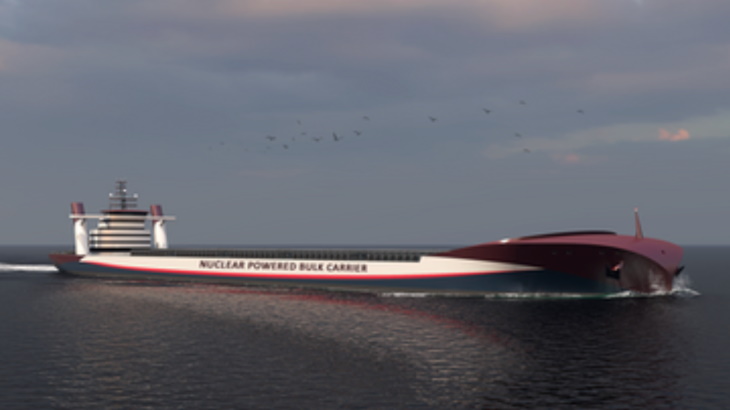Dutch nuclear energy development and consultancy company ULC-Energy BV has completed a study - supported by C-Job Naval Architects - analysing the design and economic implications of using civil nuclear reactor technology to power a Newcastlemax bulk carrier.
The study compares a nuclear-powered Newcastlemax bulk carrier - a cargo vessel with a maximum beam 50 metres and maximum length overall of 300 metres - with one powered by conventional very low sulphur fuel oil (VLSFO) and one powered by green ammonia. In collaboration with independent ship design and engineering company C-Job, the study explores the design impact, greenhouse gas emissions, and commercial performance for each fuel type.
The study concluded that the structural and safety modifications needed to integrate a nuclear reactor into a Newcastlemax bulk carrier would have minimal impact on its cargo capacity. In addition, nuclear propulsion offers the lowest operational cost per tonne shipped, significantly lower than alternatives like ammonia or VLSFO. While the lower fuel costs of a nuclear-powered ship are partly offset by the higher capital expenditures required to construct the vessel, the study found that a nuclear-powered Newcastlemax bulk carrier could sail longer, faster, and cheaper, all without producing greenhouse gas emissions.
Furthermore, it said a nuclear-powered Newcastlemax has nearly zero greenhouse gas emissions, lower even than a ship powered by green ammonia, demonstrating the potential of nuclear propulsion to support the shipping industry’s decarbonisation goals.
“This latest study from ULC-Energy furthers our mission to deliver unique, fundamentals-based analysis on the integration of nuclear technologies into various industries,” said ULC-Energy CEO Dirk Rabelink.
Niels De Vries, head of energy at C-Job, added: “The study is another remarkable milestone for the adoption of nuclear power in marine vessels. It shows how C-Job can work in a flexible manner with its clients and combine knowledge in designs that create significant value. Furthermore, it is another great example of the capability of C-Job with system integration and risk-based design to ultimately make shipping more sustainable. We valued the collaboration with ULC-Energy, specialists on nuclear technology and fuel, and look forward to working together on future projects.”
The study acknowledged that civil nuclear maritime propulsion faces licensing, operational, and other challenges. “Given that most nuclear reactor designs being considered for maritime use are still in the conceptual phase, current estimates for the capital costs of such ships are limited; however, accuracy will improve as projects mature,” ULC-Energy said.
“One possible drawback in the use of a nuclear propulsion system is the cost of its installation,” according to C-Job. “However, this is offset by the low operational expenditures and by the fact that a reactor can be used for its entire service life, either in a second ship or by extending the service life of the first ship.”
In February, ULC-Energy completed a study commissioned by global mining company BHP to investigate the potential use of civil nuclear technologies to power commercial maritime vessels. That study compared key characteristics of various civil reactor designs against the requirements for the potential use in commercial maritime shipping and evaluated a range of regulatory, operational and commercial challenges, such as port access, licensing and vessel classification, capital costs, and crew training and certification.
The shipping industry consumes some 350 million tonnes of fossil fuel annually and accounts for about 3% of total worldwide carbon emissions. In July last year, the shipping industry, via the International Maritime Organization, approved new targets for greenhouse gas emission reductions, aiming to reach net-zero emissions by, or around, 2050.



It’s been traveling underwater for quite a few years now…
(hint: subs)
Heavily regulated and operated by military engineers.
As everything nuclear should be. Relax, this won’t leave the drawing board, too much oil to burn first.